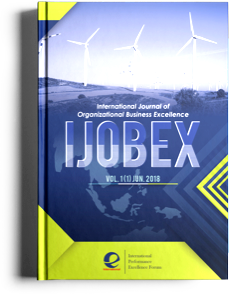Abstract
This is the case for one of the leading conglomerates based in Spain where an unfortunate event at the group´s largest frank production plant was unable to continue working, the company adopted a sense of urgency to achieve customer demand by increasing the efficiency of the rest of its production network by 25-30%. The research focuses on describing the experience of applying the concept of Operational Equipment Effectiveness in a Spanish frankfurter plant. This approach is imbedded into a Theory of Constraints scheme that ensures a positive contribution to the objective of increasing productivity with each initiative implemented. The results show that the plant was able to produce 17,5 tons per week. Lines efficiency went up by 11%, this had not been reached since the production had risen in a 28%. The combination of important tools such as OEE and TOC, resulted in important factory level discoveries, its easy replication allowed the factory to continue a horizontal deployment to the rest of 9 franks production lines
References
Dollar, D. and Wolff, E. N. (1993). Competitiveness, Convergence and International Specialization. Cambridge: MIT Press.
Fleischer J., U. and Weismann, S. N. (2006). Calculation and optimisation model for costs and effects of availability relevant service elements. Proceedings of LCE2006. http://www.mech.kuleuven.be/lce2006/154.pdf
Goldratt, E. M. (2014). The Goal: A Process of Ongoing Improvement. North River Press.
Hansen, R. C. (2002). Overall Equipment Effectiveness- A Powerful Production/Maintenance Tool for Increased Profits. New York: Industrial Press.
Huang S. H., Dismukes J. P., Mousalam A., Razzak R. B. and Robinson D. E. (2003). Manufacturing productivity improvement using effectiveness metrics and simulation analysis. International Journal of Production Research, 41(3), 513 – 527. https://doi.org/10.1080/0020754021000042391
Huang, S. H., Dismukes, J. P., Shi, J., Su, Q., Wang, G., Razzak, M. A. and Robinson, D. E. (2002). Manufacturing system modeling for productivity improvement. Journal of Manufacturing System, 21(4), 249–259. https://doi.org/10.1016/S0278-6125%2802%2980165-0
Iannone, R. and Nenni, M. (2013). Managing OEE to optimize factory performance. In M. M. Schiraldi (Eds.), Operations Management. Intechopen. https://doi.org/10.5772/55322
Ivancic, I. (1998). Development of maintenance in modern production. Euromaintenace´98 Conference Proceedings, CRO.
Nakajima, S. (1998). Introduction to Total Productive Maintenance (TPM). Cambridge: Productivity Press:
Oechser, R., Pfeffer, M., Pftzner, L., Binder, H., Muller, E. and Vonderstrass, T. (2003). From overall equipment effectiveness to overall fab effectiveness (OFE). Material Science in Semiconductor Processing, 5(4-5), 333-339. http://dx.doi.org/10.1016/S1369-8001(03)00011-8
Raouf, A. (1994). Improving capital productivity through maintenance. International Journal of Operations & Production Management, 14(7), 44-52. http://dx.doi.org/10.1108/01443579410062167
Scott, D. and Pisa, R. (1998). Can Overall Factory Effectiveness prolong Moore’s Law? Solid State Technology, 41(3), 75 - 82.
Williamson, R. M. (2006). Using Overall Equipment Effectiveness: The metric and the measures. Strategic Work Systems, Inc. Columbus. www.swspitcrew.com

This work is licensed under a Creative Commons Attribution-NonCommercial-ShareAlike 4.0 International License.

